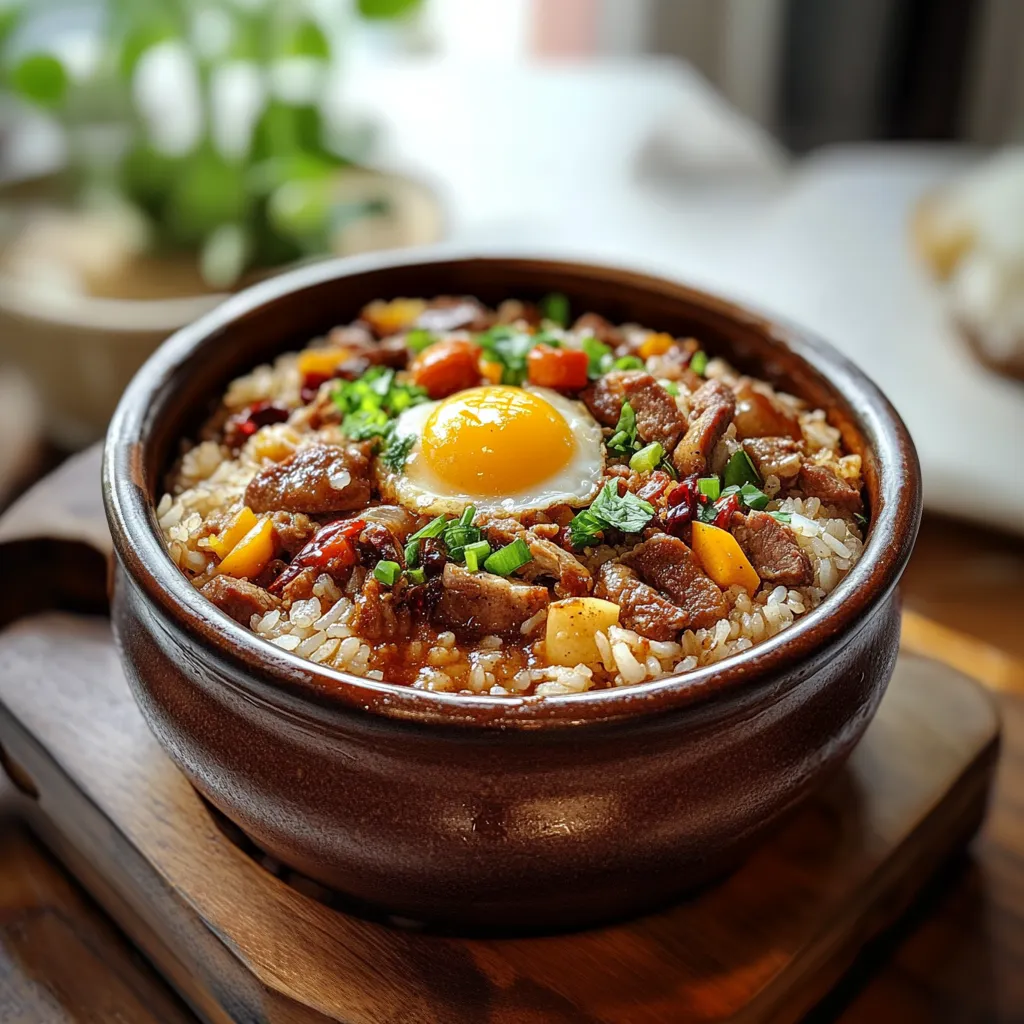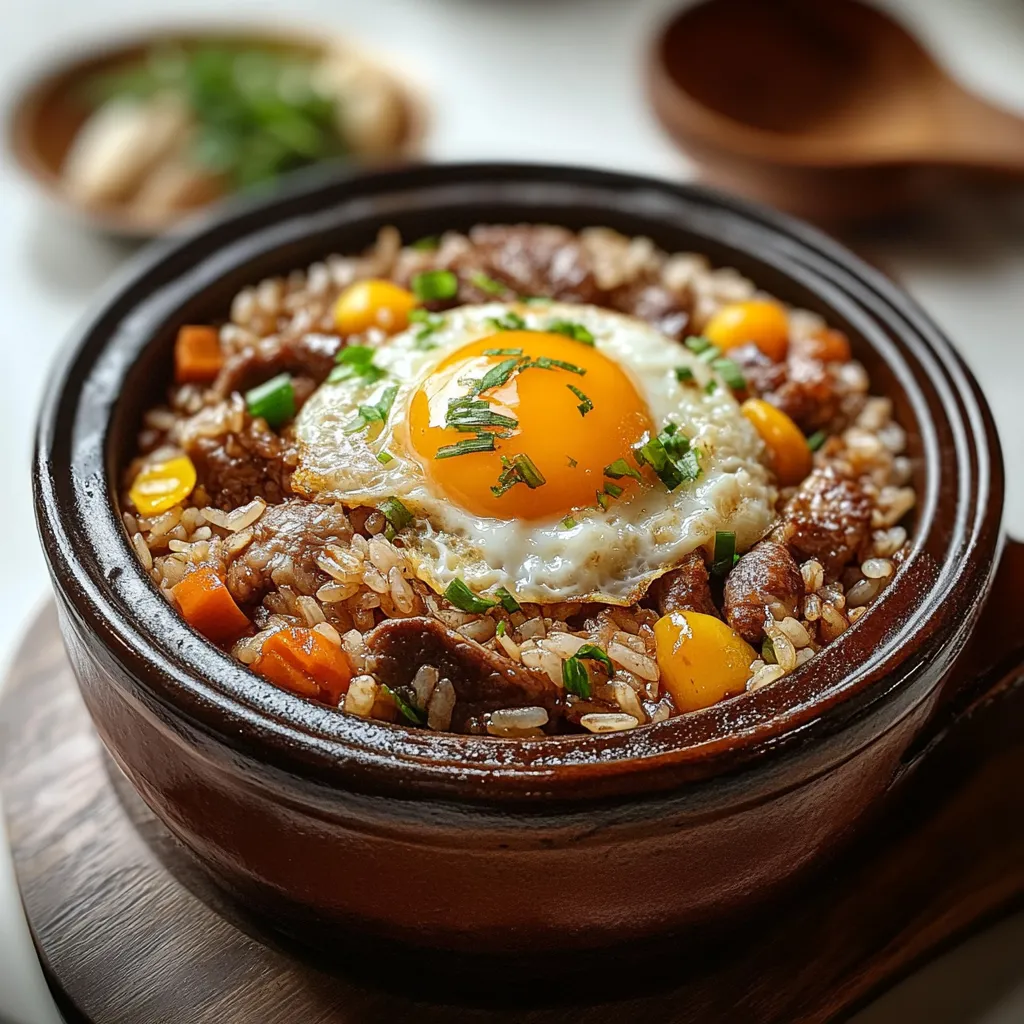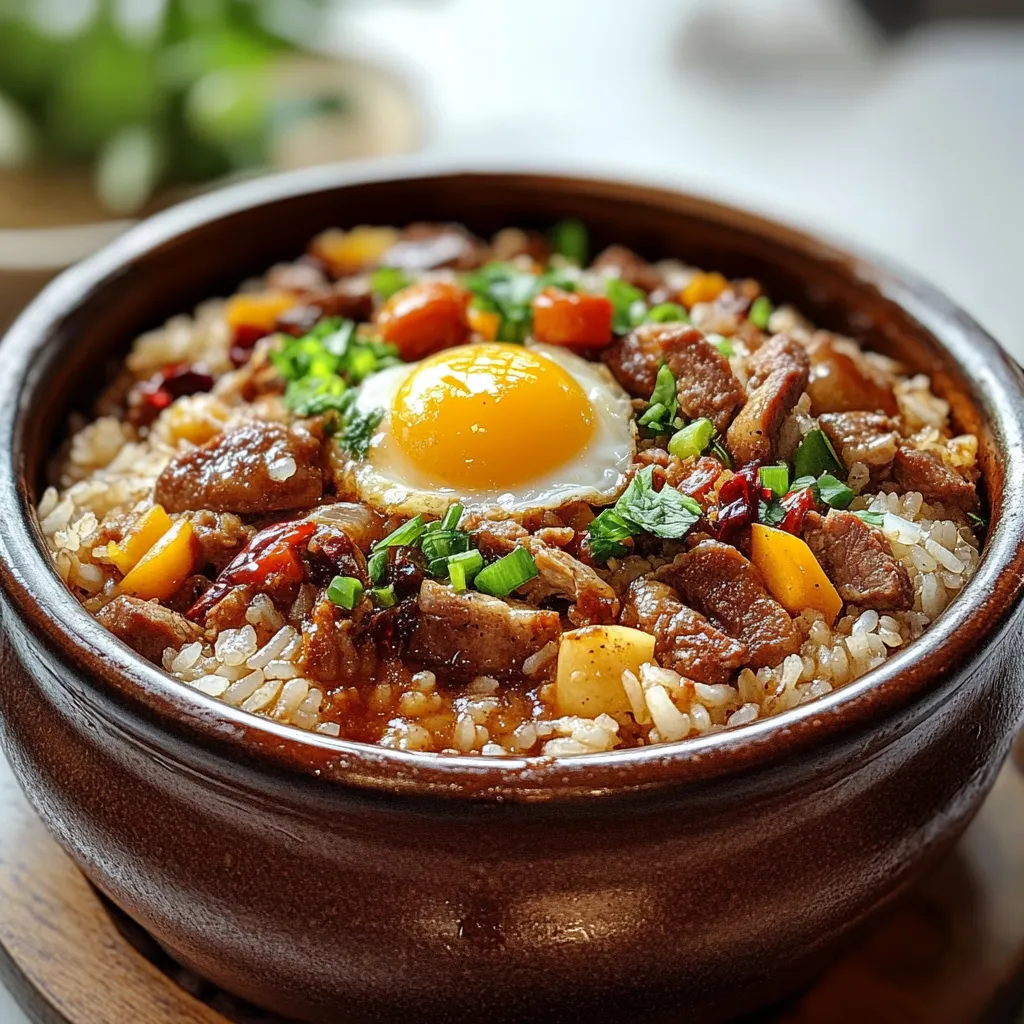 Save
Save
This Chinese clay pot rice brings traditional Asian comfort food right to your home kitchen. The combination of fragrant rice, tender meat, and fresh vegetables creates a complete meal in one pot, while the runny egg yolk adds a luxurious richness that coats every grain of rice when mixed together.
I discovered clay pot rice during my travels through Hong Kong, where I fell in love with the way the clay pot creates a deliciously crispy rice crust along the bottom and sides. After many attempts at home, this version finally captures that same magical texture and depth of flavor.
Ingredients
- Jasmine rice creates the perfect foundation with its natural fragrance and ability to develop that coveted crispy bottom
- Chicken thigh offers tender juicy bites that stay moist during the cooking process
- Shaoxing wine adds an authentic depth that cannot be replicated with other ingredients
- Sesame oil infuses the rice with a nutty aroma that permeates the entire dish
- Bok choy provides a fresh contrast to the rich meat and rice with its slight bitterness
- Egg yolk creates a silky sauce that coats the rice when stirred in just before eating
- Clay pot is traditional but a heavy Dutch oven works wonderfully if you do not have one
Step-by-Step Instructions
- Rinse and Soak the Rice
- Properly rinsing rice removes excess starch and prevents gumminess. I rinse until the water runs clear, usually 3 to 4 times, then allow it to soak for a full 20 minutes with the sesame oil. This crucial step ensures the grains cook evenly and develop the perfect texture.
- Create the Flavor Base
- Marinating the meat is essential for flavor penetration. Mix the protein with all marinade ingredients and allow at least 15 minutes for the flavors to meld. The cornstarch creates a velvety texture while the sugar balances the savory soy and umami oyster sauce.
- Layer and Cook
- Start with the rice and water in a cold clay pot, bringing it to a simmer over medium heat before reducing to low. After 10 minutes, when the rice has absorbed some water but is still quite moist, carefully arrange the marinated meat on top without disturbing the rice. This layering technique allows the meat juices to drip down and flavor the rice as everything cooks together.
- Perfect the Timing
- The final 3 to 4 minutes are crucial for adding vegetables. They should steam just enough to become tender while maintaining their vibrant color and slight crunch. Listen for a gentle crackling sound from the bottom of the pot, indicating the desirable crispy rice crust is forming.
- Create the Crown
- Adding the egg yolk off heat allows it to warm and thicken slightly without fully cooking. Place it gently in the center of the pot and cover immediately to trap the steam. The residual heat creates a glossy, barely set yolk that will enrich the entire dish when mixed in.
 Save
Save
The clay pot itself is more than just a cooking vessel in Chinese cuisine. My grandmother taught me that the porous nature of clay distributes heat gently and retains it longer, allowing flavors to develop more fully than in metal cookware. I cherish the memory of her teaching me to listen for the faint sizzling sound that indicates the perfect crispy bottom is forming.
Storage Tips
Clay pot rice maintains its flavor for up to three days in the refrigerator. Store it in an airtight container once completely cooled. The rice will absorb more flavor as it sits, making leftovers sometimes even more delicious than the original meal. When reheating, add a tablespoon of water before covering and warming on medium low heat to restore moisture.
Regional Variations
This comfort food appears across East Asia with fascinating regional differences. In Cantonese cuisine, Chinese sausage and liver often take center stage, while Taiwanese versions might include sweet preserved pork. Japanese donabe cooking follows similar principles but usually incorporates dashi for an umami boost. Each family typically has their own special combination of ingredients passed down through generations.
Serving Suggestions
Serve this dish directly in the clay pot for dramatic presentation and to keep it hot throughout the meal. Traditionally, diners scrape the crispy rice from the bottom and sides as a special treat. Accompany with a small bowl of simple clear broth and perhaps some pickled vegetables to cleanse the palate between bites of the rich, savory rice.
 Save
Save
Recipe FAQs
- → Can I make clay pot rice without an actual clay pot?
Yes, you can use a heavy-bottomed pot or Dutch oven instead of a traditional clay pot. The results won't be exactly the same (you might miss some of the characteristic crust), but a good quality cast iron or thick-bottomed pot will produce delicious results. Just ensure it has a tight-fitting lid to trap the steam properly.
- → What's the best rice to use for Chinese clay pot rice?
Jasmine rice or short-grain rice work best for clay pot rice. These varieties have the right starch content to create the desirable texture—fluffy on top and slightly crispy on the bottom. Long-grain rice can be used but may not develop the same authentic texture.
- → Is the egg yolk safe to eat since it's not fully cooked?
The residual heat from the hot rice will partially cook the egg yolk, making it safe for most people. If you're concerned about consuming partially cooked eggs, you can either use pasteurized eggs or fully cook the egg by adding it earlier in the cooking process, or substitute with a fully cooked fried egg on top.
- → What vegetables work best in clay pot rice?
Traditional options include bok choy, Chinese broccoli (gai lan), shiitake mushrooms, and wood ear mushrooms. However, you can use other vegetables like Chinese cabbage, spinach, carrots, or snow peas. Just ensure they're cut into sizes that will cook properly in the short steaming time at the end.
- → How do I get the crispy rice bottom in clay pot rice?
The crispy bottom (called 'fan jiao' in Cantonese) comes from the direct heat on the bottom of the clay pot. To achieve this, don't stir the rice during cooking, use the right amount of liquid (not too much), and cook on medium-low heat in the final stages. Some cooks add a little oil to the bottom of the pot before adding rice to enhance the crispiness.
- → Can I prepare any components ahead of time?
Yes, you can marinate the meat up to 24 hours in advance and keep it refrigerated. You can also prepare the vegetables and sauce beforehand. The rice should ideally be soaked right before cooking, but in a pinch, you can rinse and drain it ahead of time. The actual cooking process should be done just before serving for the best texture and flavor.
